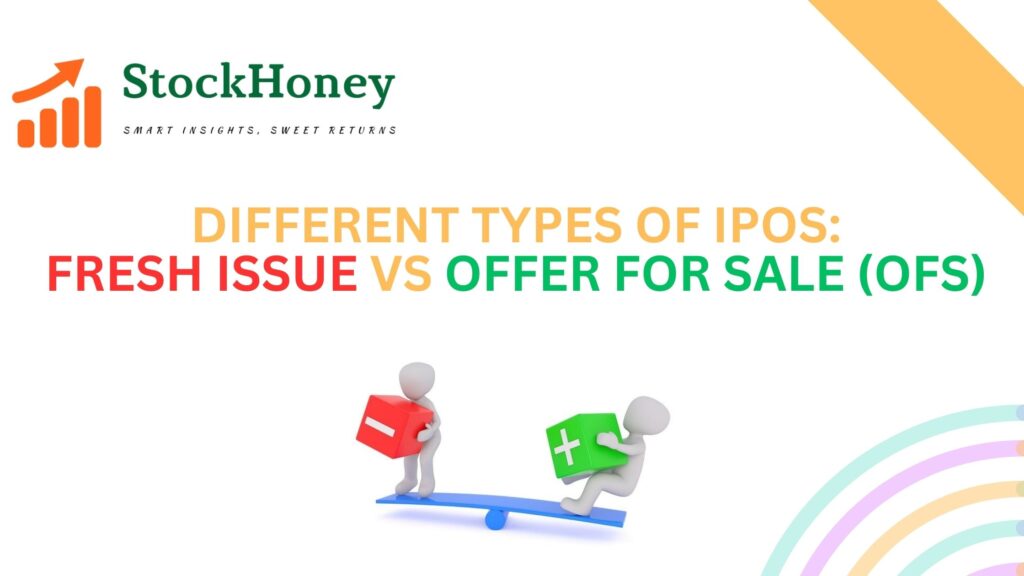Initial Public Offerings, or IPOs, provide companies with access to funds from the public and a means for investors to own small portions of companies that can be perceived as high growth. But all IPOs are not alike. Rather, two primary types populate the IPO market: Fresh Issues and Offers for Sale, or OFS
Knowing, the difference between the two is important for investors to make an informed decision as each type has different implications for the issuing company and potential shareholders.
In this chapter, we will examine the difference between a Fresh Issue and an Offer for Sale and the implications it holds both for companies going public and for investors.
What is an IPO?
An Initial Public Offering, or IPO, refers to the process by which a private company issues shares to the public for the first time to raise funds, thereafter the company becomes a listed entity. IPOs not only help companies raise funds but also enhance their reputation, bring greater transparency, and provide liquidity to early investors or shareholders. Companies use IPOs mainly for business expansion, paying off debts, or other strategic objectives.
The two most common types are Fresh Issues and Offer for Sale (OFS). Both serve different purposes and carry unique benefits and limitations for investors. Here’s a closer look at each.
Fresh Issue: Raising New Capital
A Fresh Issue can also be termed as a Primary IPO. During this issue, new shares are issued by the company to generate more money. The raised capital will then be utilized for any of the purposes the business requires it for. This may involve business expansion, research and development, and debt settlement. In this case, the equity base of the company is expanded because fresh shares are created and sold to the public.
Important Features of Fresh Issue
- Increases the Share Capital: Because new shares are issued, the total share capital of the company increases, which leads to the dilution of the present shareholders’ ownership.
- Capital Utilization: The money realized from a Fresh Issue is the company’s to keep. It gives that company some much-needed funds to carry out growth and other initiatives.
- Equity Dilution: If the company issues more shares, the percentage ownership of existing shareholders in the company reduces even though they hold the same number of shares. This is called dilution, which occurs in the case of Fresh Issues.
Example of a Fresh Issue
In 2021, the IPO of Paytm was a combination of a Fresh Issue and an Offer for Sale. Through the Fresh Issue, the company raised around Rs. 8,300 crore ($1.1 billion). The amount was set aside for growth initiatives, debt repayment, and for expansion. The amount raised through the Fresh Issue provided the company financial foundation to pursue strategic goals.
Here are the pros and cons of Fresh Issue for investors
Pros
- Provides more resources for the company to grow
- The amount received from the IPO is invested by the company in growth initiatives
- Potential long-term growth for investors
Cons
- Dilution of existing ownership
- Volatility in the market might impact the share price
- Risk if the funds received from IPO are not utilized effectively
Offer for Sale (OFS)
An Offer for Sale(OFS) is different from a Fresh Issue. Unlike a Fresh Issue where new shares are issued by the company to the public to raise funds, in an Offer for Sale the existing shareholders, such as promoters, venture capitalists,s or private equity firms, sell a portion of their stakes in the company to the public. The money received from the sale of the stake goes to the selling shareholders and not to the company. OFS is also referred to as a secondary IPO.
Key Features of an Offer for Sale
Fresh capital is not raised: No fresh capital is raised as shares are transferred from the existing shareholders to the public.
Provides Liquidity to Early Investors: An OFS allows early investors or promoters to sell a portion of their holdings.
No Ownership Dilution for Existing Shareholders: Since no new shares are issued, the ownership percentage of shareholders who have not sold their shares remains unaffected.
Example of an Offer for Sale
A good example of OFS is Reliance Nippon Life Asset Management’s IPO in 2017. This OFS allowed Nippon Life and Reliance Capital to sell part of their holdings to the public. Through this sale, no new capital was raised by the company, but it provided an exit route to the existing investors while bringing in public shareholders.
Pros and Cons of an Offer for Sale for Investors
Pros
- No dilution of existing shares
- Allows early investors to cash out
- This can signal maturity and stability as it indicates that the company has reached a stage where early investors feel confident enough to exit or reduce their stake
Cons
- Proceeds don’t directly benefit the company
- Limited potential for growth-driven returns as the proceeds from share sales don’t go to the company
- Risk of high valuations due to early exits
Key differences between Fresh Issue Vs Offer for Sale
| Fresh Issue | Offer for Sale | |
| Purpose of Issue | Raise capital for the company | Provide liquidity to existing shareholders |
| Impact on capital | Increase in Share Capital | No change in share capital |
| Utilization of proceeds | For growth initiatives, expansion, or debt repayment | Proceeds go to selling shareholders |
| Impact on Ownership | Ownership of existing shareholders is diluted | No impact on Ownership |
Here’s what investors should know before investing in an IPO
Requirement of the company for an IPO
Know whether the IPO is a fresh issue or an OFS. In case of a fresh issue, the proceeds from the IPO would most likely be used for strategic initiatives and expansion that could positively impact the growth of the company. In OFS the investor money is used to pay the sellers and this may not have an immediate impact on the growth of the company.
Financial Health and Business Model
Understand the financial health of the company by thoroughly understanding the financial statement, business, and revenue model. The DRHP filed by the company with SEBI has all the required and necessary information.
Market Conditions
The market conditions might also impact the performance of the IPO. For example, in a bullish market, IPOs tend to do well.
Company Valuation
Analyse IPO pricing. A higher valuation may reflect optimism but chances are there could be a correction in share price once it starts trading on the exchanges due to overvaluation.
Conclusion
Both a fresh issue and an offer for sales (OFS) bring with them unique opportunities and challenges for an investor. A fresh issue helps a company to raise funds to fuel further growth while an offer for sale provides liquidity to early shareholders.
Knowing the type of IPO and also the growth prospects and financial health of the company will help investors with informed investment decision-making. Of course, no investment is completely risk-free, but a closer scrutiny of these factors will enhance the probability of a successful investment.
For more information on the company issuing the IPO, always check the DRHP on the SEBI website. It will help an investor to make far better-informed decisions than just relying on hearsay or hype.
Happy IPO Investing!
Related Information & Articles
Current & Upcoming IPOs in India
8 Case Studies – Successful and Failed IPOs
Important Role of Anchor Investors in IPOs
Insider Selling in IPOs: Find the Red Flags


